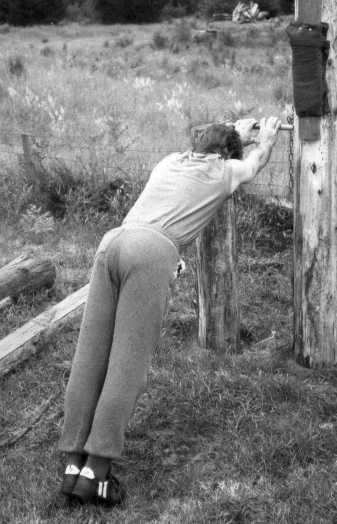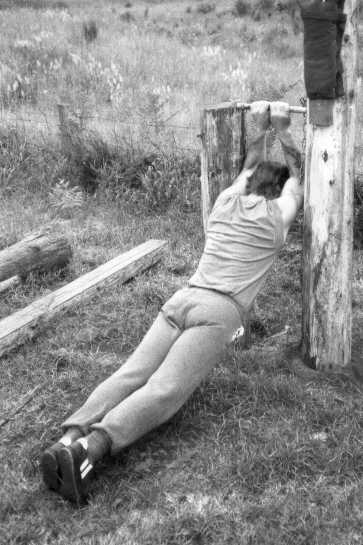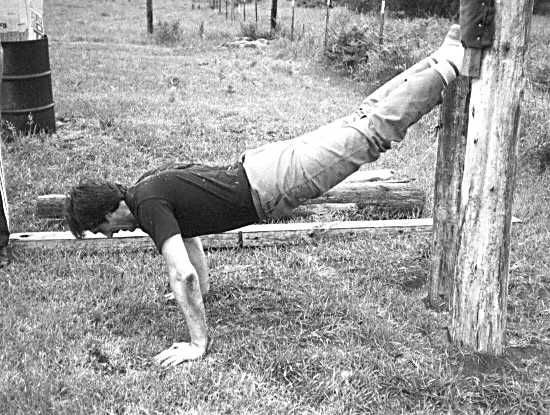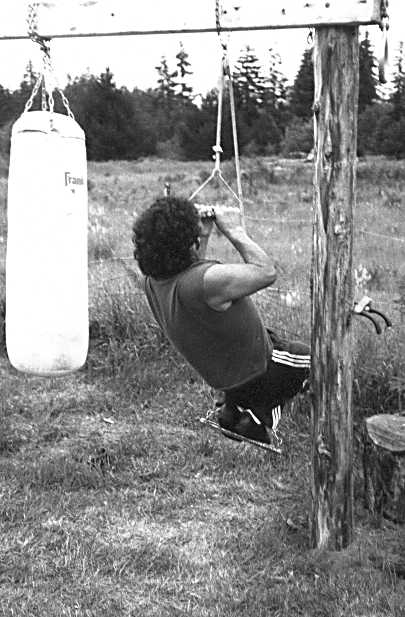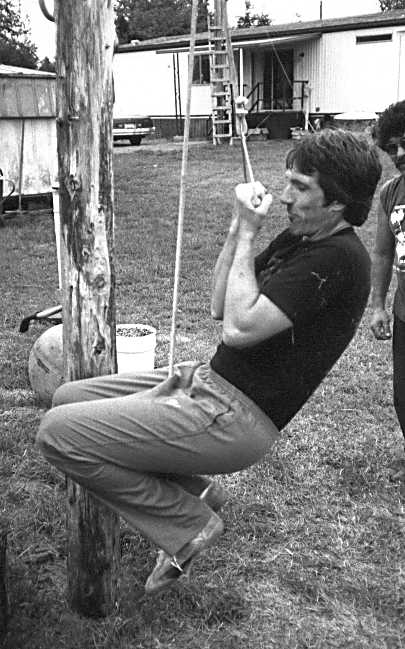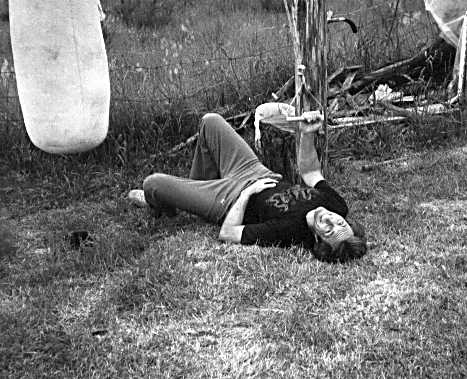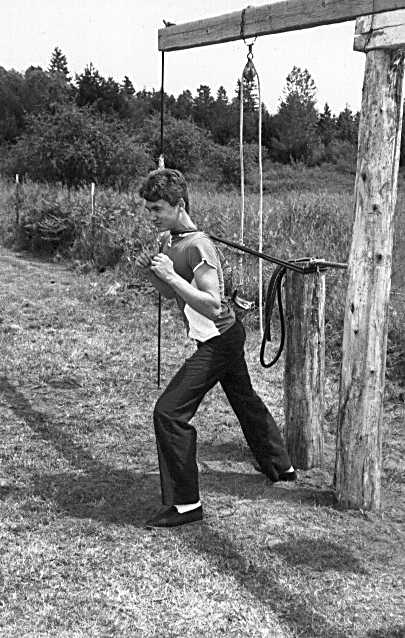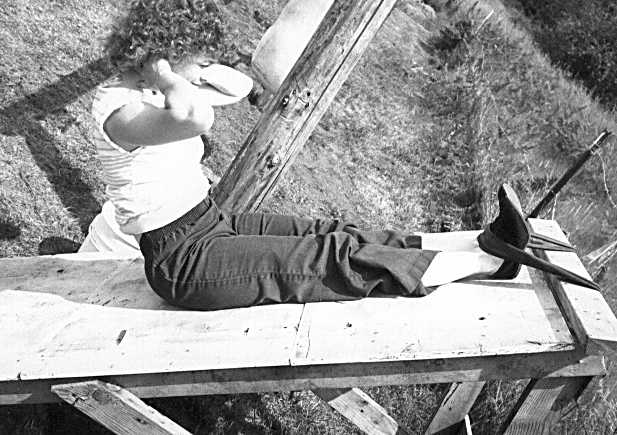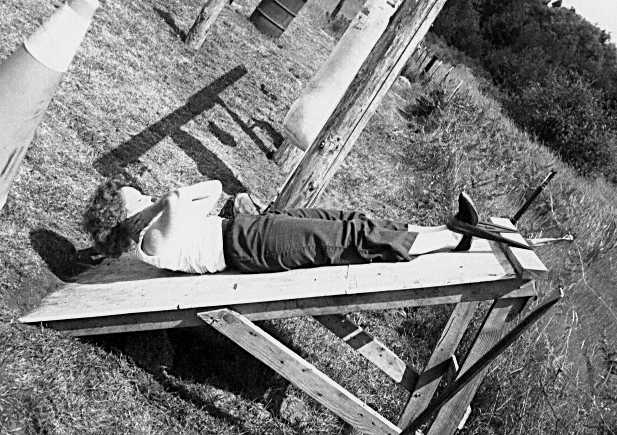|
Exercising
With the Master
Please...if you like coming, lend your
support! If you benefit from what you find here,
show your appreciation with a contribution.
Doing so will assure our continued presence on line,
and expansion into new areas of interest over
time. We have many plans and ideas for the
future, but will require significant upgrades in video
recording equipment, software and computer hardware,
on top of the increasing expenses for web volume and
throughput. As it stands, we are extended to the
limit of available resources.
Cast your vote with a donation!
WE REALLY NEED YOUR HELP!!!
Please note that Iron Crane Dojo is not
a “not for profit” organization. Donations are not
tax deductible. Whether you able to donate or not,
please understand you will remain our friend and
continue to be welcomed at Iron Crane Dojo.
In the lowlands south of
Olympia, Washington, there is a martial arts class
unlike any you have ever seen. Members of this class pay
no fee for their instruction (at least not when this was
originally published in July 1987) and work out only at
the invitation of the head instructor. The workouts are
spartan in nature, and visiting Black Belts are
frequently humbled at not being able to perform even the
most basic class routines.
The head instructor is
Isidro Archibeque. Master Archibeque has achieved
considerable notoriety in the Pacific Northwest for his
flamboyant style and awesome breaking demonstrations.
Because he does not earn his livelihood from teaching
martial arts, Master Archibeque has the luxury of
hand-picking students. Those students who have accepted
his invitation range from experienced Black Belts to
chance sidewalk acquaintances. As one student explained,
"Master Archibeque really has an open door policy. His
only requirement is that students have a good attitude
and a willingness to learn. Those attributes are hard to
find and are just as common in novices as they are in
Black Belts, hence his unusual method of selecting
students."
Interestingly, because
of his somewhat reclusive nature, there was once a time
when others questioned Archibeque's authenticity.
However, over the years, scores of Black Belts from all
styles have had opportunity to test their skills against
this gentleman and have first-handedly experienced his
mastery. One renowned Northwest tournament competitor
remarked that, "I haven't been able to stay on my feet
for more than thirty seconds against the guy. I've
studied for fifteen years, and I don't even know what he
did to me. All I remember is whenever I executed an
attack, I was suddenly on the ground, in pain, and
unable to move."
Master Archibeque's life
reads like the script from a martial arts movie. Of
mixed Japanese and Spanish descent, he lost his natural
parents at an early age while living in Japan. Being
raised by his grandparents, he was assigned to a
Buddhist temple in Japan where most of the daily
activity focused on perfection of the martial arts. His
years in the temple spanned World War II, and he had
many opportunities to study personally with the great
masters of that era. Moreover, he was afforded
opportunities to travel throughout Asia to study with
masters from other countries. His command of knowledge
reportedly spans 26 styles of fighting.
Master Archibeque's
scope of knowledge is staggering. Sensei Roy Kauffroath,
of the Bremerton, Washington Sam Pai Kenpo Organization,
notes that, "On one afternoon, I saw Master Archibeque
refine the forms of an Isshinryu Black Belt, instruct
another student in Tai Chi, coach another man on Arnis
and demonstrate principles of Ai Ki Do." As Don
Wasielewski, 8th degree Isshinryu Black Belt explains,
"The first time I heard this guy talking, I thought it
was all baloney, but when I threw a punch, and he
grabbed my arm, it felt as though a vice had locked onto
me. I’ve never felt anything like it."
Though a master of many
styles, "Archie", as he is affectionately called,
specializes in the Iron Hand . His assortment of
Iron Hand skills includes breaking boards with his
fingertips, 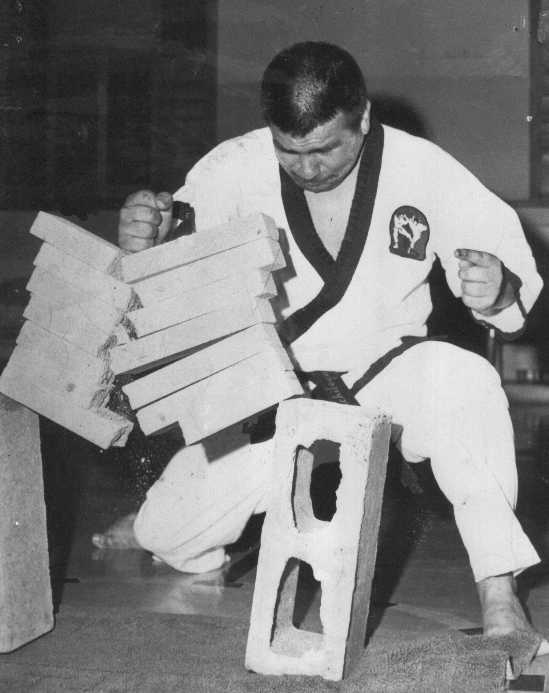 driving nails into studs with his open
palm, splitting 2x4's, bricks, tiles and river rocks
(for which he is best known). A Black Belt visiting his
workout area recalls that, "We had been working out and
were taking a break when I heard a terrific pounding
sound coming from my rear. I turned to see Archie
relaxing by punching a nearby tree. It was
extraordinary! Here was this little man punching a tree
hard enough for bark to be splintering off the tree, and
branches and leaves were beginning to fall." driving nails into studs with his open
palm, splitting 2x4's, bricks, tiles and river rocks
(for which he is best known). A Black Belt visiting his
workout area recalls that, "We had been working out and
were taking a break when I heard a terrific pounding
sound coming from my rear. I turned to see Archie
relaxing by punching a nearby tree. It was
extraordinary! Here was this little man punching a tree
hard enough for bark to be splintering off the tree, and
branches and leaves were beginning to fall."
Because of his Iron Hand
specialty, Archibeque has had to devise methods to
maintain himself in the highest state of physical
conditioning at all times. Though he is 53 years old (at
the time of the original article that is, his birthdate
is May 12, 1933), he looks to be much younger and in the
Northwest is notorious for his legendary physical
conditioning, strength and stamina. Taking a break from
a recent workout, David Wightman, a long-time student,
noted that, "Though Archie is most known for his
extraordinary breaking demonstrations and his fighting
skills, his greatest contribution to the martial arts
may be his sophisticated understanding of exercise,
enabling him to use pieces of junk, cast-offs and
ordinary household objects to create machines and
devices capable of developing super-conditioned bodies
in even the most ordinary martial artists. With Archie,
there is simply no reason for not being in perfect
physical condition. First, he teaches you how to attain
a level of maximum conditioning, then he perfects your
martial art. It's that simple!"
One recent
Saturday, I went to his home to interview him on another
article I was working on. Keeping close to nature, he
lives in a rural setting where he can practice his arts
without attracting undue attention from the neighbors.
While there, I found an amazing array of exercise
devices scattered about his yard. Our conversation
quickly turned to the devices, which he jokingly
referred to as "my Ninja camp ."
Master
Archibeque with some of the exercise stations at his
outdoor workout area.
When I originally
suggested presenting some of his ideas to the readers of
Tae Kwon Do Times, Master Archibeque expressed
delight at sharing his philosophy with the proponents of
Tae Kwon Do, to whom he acknowledges a considerable debt
of gratitude for concepts passed to him during his
formative years. My interview with Archie follows:
Mc Cabe: We all have
reasons for incorporating "exercise" into our martial
arts workout regimen. For some people, it's only to
loosen up. For others, it's to develop strength in
particular parts of the body, or even to improve
overall endurance if the exercise is aerobic. How do
you feel exercise ties into a martial arts program?
Archibeque: The
significance of exercise is two-fold. First, your body
should be able to do anything you ask it to do. Second,
your mind must be completely disciplined, for, with an
undisciplined mind, the body's performance will fall far
short of its potential. Throwing punches and kicks into
space will not accomplish those two objectives -- nor
will sparring or practicing forms.
Sort of like using
exercise to mold an attitude that does not admit
defeat or accept limits?
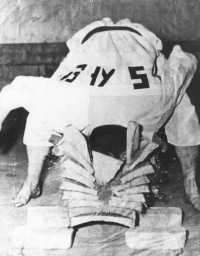 That's right! I call it "Mind
Over Matter ." With the right approach toward
exercising, the instructor will develop students whose
minds reject limits and who have the confidence,
strength and stamina to execute the appropriate response
for every situation. That's right! I call it "Mind
Over Matter ." With the right approach toward
exercising, the instructor will develop students whose
minds reject limits and who have the confidence,
strength and stamina to execute the appropriate response
for every situation.
Isn't that what
exercise is all about anyway?
Exercise is what you make
of it! If you go through your exercise half asleep,
you're doing nothing more than loosening up. Your
approach to exercise should be relative to what you
expect from exercise. In my mind, I think of exercise as
having four different levels. On the basic level, there
is mild exercise, like that done by the office worker
trying to maintain a fixed waistline. The next level
would be what I describe as athletic conditioning. This
is the person who is regularly doing some sort of
activity, such as playing on a basketball team or
working out regularly at some activity. Next would be
high level athletic conditioning, which would be that of
most professional athletes and the majority of Black
Belt martial artists. The highest level is what I've
described above as the level of "Mind Over Matter." Mind
over matter is literally the ultimate goal of this
exercise approach. Through careful analysis of each
activity, you are always striving toward developing that
body which gives your mind complete freedom to do
anything that you want. This should be the destination
of any student whose ultimate goal is to be a proficient
martial artist.
But, don't most people
dislike exercise routines?
That's because they don't
truly understand exercise. For some people, doing bench
presses is great fun. For others, swimming is fun. Some
enjoy running, and others enjoy throwing hundreds of
kicks into space. All have meaning and value so long as
you are doing them for the right reason. However, most
people are simply not motivated to adopt those
approaches. Some don't even find them enjoyable ... or,
because of limited funds, can't afford them. With "Mind
Over Matter", we are dealing with an exercise
philosophy. Everything you need is in your mind and your
body. You should be able to walk into any room of a
house and within minutes have identified everything that
you need to maintain your level of conditioning. And I'm
talking about doing exercises that you find challenging
and enjoyable.
Are you saying that
the popular exercise programs are inadequate?
That depends on your
objective. If you want cardiovascular conditioning,
jogging and swimming might be appropriate (At this
point, Archie did note he preferred walking to jogging).
Doing lots of push-ups and sit-ups will take some
calories off and help your clothing to fit a little
better. If you're looking for muscular bulk, a weight
lifting program can be tailored to your needs. Our
objective is complete discipline, and again, to have a
body that does what you want it to do when you tell it
to.
Why can't regular
exercises get you there?
Because they are
inherently self-limiting. A normal push-up will simply
work a few isolated muscle groups. Doing the same
push-up with your hands two-and-a-half feet beyond the
top of your head will work your entire body.
In other words, you
require that all of your students learn certain
exercise patterns as part of their training?
No! I work with them to
develop their own philosophy of exercise. Then I teach
them how to make that philosophy a reality.
Can you give us some
insight into this "philosophy"?
Well, it is difficult to
cover everything in the confines of this interview, but
there are four facets of my exercise philosophy which
can be communicated pretty directly.  First
is that any exercise should be fun to do. Second is that
it should be safe. Third is that it should always be
challenging. As soon as an exercise becomes routine, it
should immediately be modified so that it once again
becomes challenging. A good example is the push-up
already described. Last, and this is unique to my
approach and is certainly controversial with other
instructors, is that I feel exercise should be awkward.
One can do multiple repetitions of standing and pressing
a 150 pound weight and would not gain nearly the benefit
that he would in attempting to do 2-3 repetitions of
lifting a 50 pound log to the same press position. The
reason for this is the log is not balanced like the
weight, has no easy grip and is unwieldy. The exerciser
struggles to raise the weight to his chest, virtually
wrestling with the log just to prevent it from falling,
then works every part of his body, attempting to keep it
balanced on his fingertips as he lifts it carefully to
the topmost position. Try it sometime! First
is that any exercise should be fun to do. Second is that
it should be safe. Third is that it should always be
challenging. As soon as an exercise becomes routine, it
should immediately be modified so that it once again
becomes challenging. A good example is the push-up
already described. Last, and this is unique to my
approach and is certainly controversial with other
instructors, is that I feel exercise should be awkward.
One can do multiple repetitions of standing and pressing
a 150 pound weight and would not gain nearly the benefit
that he would in attempting to do 2-3 repetitions of
lifting a 50 pound log to the same press position. The
reason for this is the log is not balanced like the
weight, has no easy grip and is unwieldy. The exerciser
struggles to raise the weight to his chest, virtually
wrestling with the log just to prevent it from falling,
then works every part of his body, attempting to keep it
balanced on his fingertips as he lifts it carefully to
the topmost position. Try it sometime!
Author
Bill Mc Cabe accepts Archie's invitation to try it
sometime!
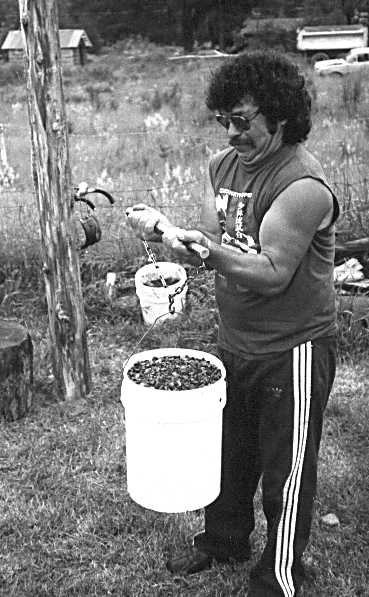 At
this point, Master Archibeque and I terminated the
interview, and I agreed to "try it" as he had
suggested. As the photographs show, the lift
proved to be quite a struggle for myself, even though
I can routinely stand and press in excess of 150
pounds. I asked that he walk us through some of his
other stations and explain how they are used. His
explanation follows. At
this point, Master Archibeque and I terminated the
interview, and I agreed to "try it" as he had
suggested. As the photographs show, the lift
proved to be quite a struggle for myself, even though
I can routinely stand and press in excess of 150
pounds. I asked that he walk us through some of his
other stations and explain how they are used. His
explanation follows.
Archibeque: "We've all
done curls using balanced weights, and there is no
question this kind of exercise is of benefit in
increasing strength. Try filling a 5 gallon bucket with
pebbles (Photo #5), or an old rice sack with sand, and
do the same curl. Notice the entirely different feel as
your body must contend with an unwieldy, awkward weight.
While you struggle to maintain your balance, work
variations of the normal curl routine. Try holding the
weight straight out, try doing it with one arm. Learn to
use your arms only, don't use your body for added
leverage. To help ease the pain of the exercise, think
of the money you saved by using scrap objects to create
the device."
|

|

|
Lifting
the sand filled rice sack requires great
focus in its own right, even before
extending it out to arm's length.
The level of muscular discipline is self
evident.
|
"A piece of scrap wood
can present a sophisticated exercise challenge if done
with the right attitude." (At this point, Master
Archibeque picked up a piece of wood 1"x6"x4' long,
put one of the ends beneath his midsection, jumped up
in the air and started to balance himself on the wood.
As you can see from the accompanying photographs, I
was not nearly so agile.)
What
Archie made look easy proved to be excruciatingly
painful for myself.
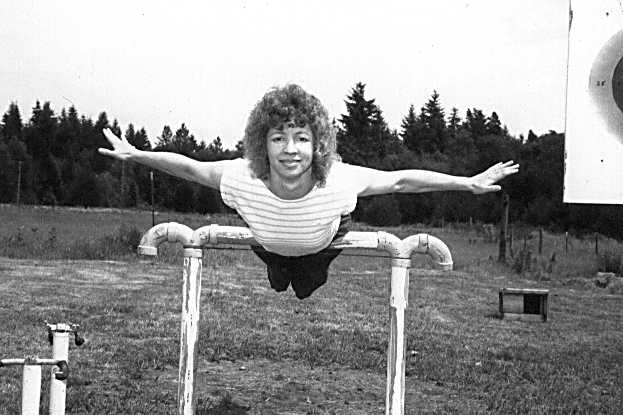 "Even something so ordinary as
a horizontal bar presents genuine challenges. The next
time you see a horizontal bar, lie with your center of
gravity directly on the bar, then attempt to straighten
your body into one line. If you can do this, you can
join my class! If you can't, be satisfied with that
special feeling your body will have after having been
well-worked. Once you've mastered that exercise, stay on
the bar then try bending, touching your toes and
fingertips to the ground, then return to the horizontal
... the variations are endless." "Even something so ordinary as
a horizontal bar presents genuine challenges. The next
time you see a horizontal bar, lie with your center of
gravity directly on the bar, then attempt to straighten
your body into one line. If you can do this, you can
join my class! If you can't, be satisfied with that
special feeling your body will have after having been
well-worked. Once you've mastered that exercise, stay on
the bar then try bending, touching your toes and
fingertips to the ground, then return to the horizontal
... the variations are endless."
"We've all done pull-ups.
The next time you do pull-ups, raise your legs so that
they're perpendicular to your upper torso. When you
master this, if you ever do, go to the next level, which
is to bring your toes up until they touch the bar. Can
you think of any other variations?"
"Suspending a bar four
feet off the ground opens up a universe of activities,
completely working the entire body. The accompanying
pictures are worth ten thousand words."
This is the
"Chinese stretch", a routine which combines several
exercise functions into a single routine.
Around
the world on a horizontal bar, the Archibeque
way. exercises such as this are geared for
total body development, nothing less.
"One of the truly fun
exercises is based upon the principle of a pulley. At
our camp, we have a pulley supporting a tree stump which
alone weighs approximately 50 pounds. It doesn't take
long before most students have worked through the usual
pulley exercises, and since everyone seems to know them
anyway, there's no need to rehash them here. Remembering
the goal of "Mind Over Matter", observe how in the
following photographs I am standing on the stump, then
pulling the stump and my own body weight upward with the
pulley.
|
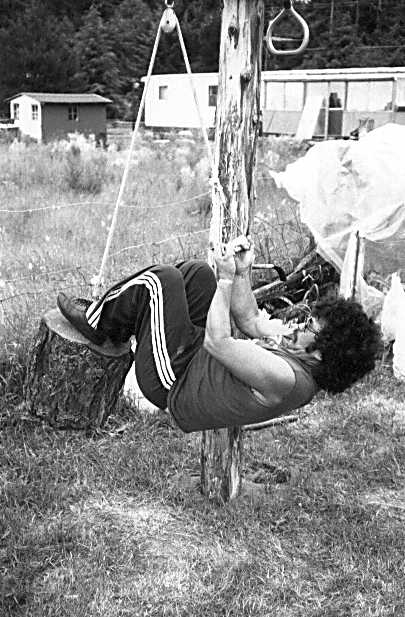
|
Suspended in
air by the pulley, Archibeque lifts by
pulling with his arms, then lowers by
pushing downward with his feet. While
developing great strength, he simultaneously
perfects the ability to confidently maneuver
with his body floating awkwardly in space.
|
In addition to requiring
considerable strength, the exercise demands intense
concentration and a high level of balance. One wrong
move and the stump pops out from under my feet, allowing
my body to fall to the ground. If that's not bad enough,
the stump wants to follow immediately behind the body
... and most certainly will if I let go of the handle.
All jokes aside, the beauty of this exercise is that you
are suspended in free space, pulling your body up with
your hands, and after arriving at the flexed position,
you work with your feet to straighten the body by
pushing the stump back toward the ground. Do five of
these and call it a day."
"For further challenge,
do the same exercise with a bar in place of the wood
stump. The routine becomes a drill requiring
extraordinary balance and concentration. One slip of the
bar from underneath the feet, and the student is on the
ground.
As the
reader can see from the accompanying photographs,
the exercise proved to be a little more than the
author could master on this first occasion.
Here
a student develops his neck musculature, and
perfects his ability to move with control while
managing the resistance produced by some salvaged
pieces of rubber tubing.
"Concluding my comments,
I would like to emphasize there is an unlimited
constellation of machines and devices you could easily
create from scrap objects sitting around your house and
garage. This student is using flexible rubber
tubing to work the muscles in his neck and to perfect
his stances under stress."
|
Archibeque
uses a garage door spring to perfect
ground sweeps against an opponent's
exposed leg.
|

|
" Here, I am using a
junkyard garage door spring to work the muscles in my
leg. The feel of this device is strikingly similar to
the feel of doing leg take-downs against attacking
opponents. The last sequence shows how a few pieces of
scrap wood and a used bicycle inner tube make a first
class exercise platform for sit-ups."
Scrap wood and an
old bicycle inner tube are all that's necessary to
build a comfortable but challenging sit up platform.
Author's Note: As you
can see from the photos of these exercises and from
the devices, Archibeque's approach to exercise demands
a great deal of thought and creativity.
He explains, "I am not
trying to build carbon copies of myself out here. My
goal is to work with each artist who comes to my school
and to help that artist develop his or her own style. I
believe there is only one style and that is what you
make of what you have learned. All I am is the waiter,
holding the platter with an assortment of entrees. Like
a fish, you can taste this one, or that one, but what
you finally take with you is your decision, and you must
be prepared to accept the benefits, or the consequences.
My goal is to teach you a creative philosophy that
begins with a conditioning program that will take you to
wherever you want to go. I would hope that in the end,
you would be able to apply these concepts in true
improvisational fashion so that your martial art is
always there to serve your needs in your life
experience. Tell your readers good luck, and God bless."
|
Click
Below to View as a Slide Show
|
|
|
|
Here’s
a Glimpse at the Original Camp
|
|
|
|

 driving nails into studs with his open
palm, splitting 2x4's, bricks, tiles and river rocks
(for which he is best known). A Black Belt visiting his
workout area recalls that, "We had been working out and
were taking a break when I heard a terrific pounding
sound coming from my rear. I turned to see Archie
relaxing by punching a nearby tree. It was
extraordinary! Here was this little man punching a tree
hard enough for bark to be splintering off the tree, and
branches and leaves were beginning to fall."
driving nails into studs with his open
palm, splitting 2x4's, bricks, tiles and river rocks
(for which he is best known). A Black Belt visiting his
workout area recalls that, "We had been working out and
were taking a break when I heard a terrific pounding
sound coming from my rear. I turned to see Archie
relaxing by punching a nearby tree. It was
extraordinary! Here was this little man punching a tree
hard enough for bark to be splintering off the tree, and
branches and leaves were beginning to fall." 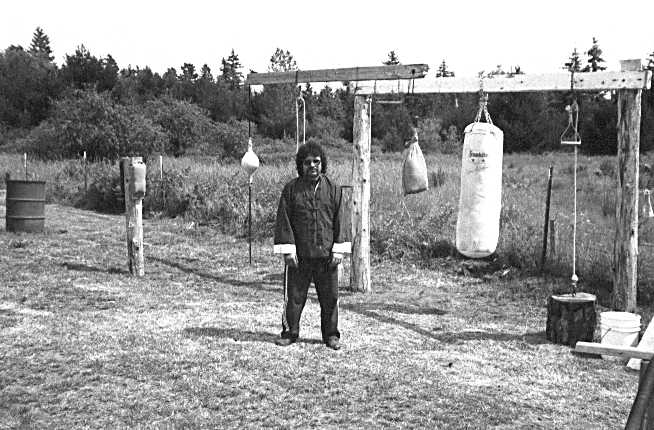
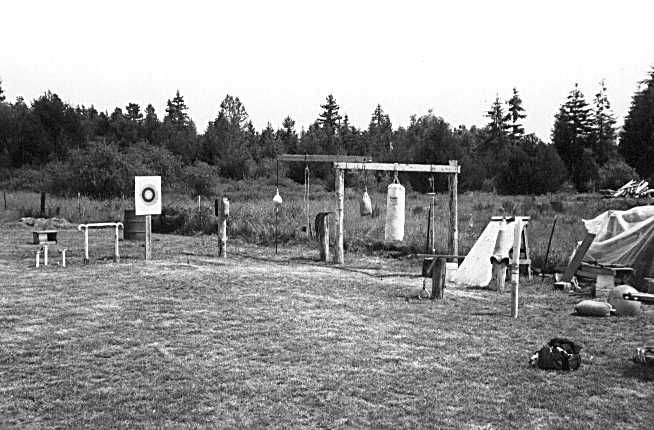
 That's right! I call it "Mind
Over Matter ." With the right approach toward
exercising, the instructor will develop students whose
minds reject limits and who have the confidence,
strength and stamina to execute the appropriate response
for every situation.
That's right! I call it "Mind
Over Matter ." With the right approach toward
exercising, the instructor will develop students whose
minds reject limits and who have the confidence,
strength and stamina to execute the appropriate response
for every situation.  First
is that any exercise should be fun to do. Second is that
it should be safe. Third is that it should always be
challenging. As soon as an exercise becomes routine, it
should immediately be modified so that it once again
becomes challenging. A good example is the push-up
already described. Last, and this is unique to my
approach and is certainly controversial with other
instructors, is that I feel exercise should be awkward.
One can do multiple repetitions of standing and pressing
a 150 pound weight and would not gain nearly the benefit
that he would in attempting to do 2-3 repetitions of
lifting a 50 pound log to the same press position. The
reason for this is the log is not balanced like the
weight, has no easy grip and is unwieldy. The exerciser
struggles to raise the weight to his chest, virtually
wrestling with the log just to prevent it from falling,
then works every part of his body, attempting to keep it
balanced on his fingertips as he lifts it carefully to
the topmost position. Try it sometime!
First
is that any exercise should be fun to do. Second is that
it should be safe. Third is that it should always be
challenging. As soon as an exercise becomes routine, it
should immediately be modified so that it once again
becomes challenging. A good example is the push-up
already described. Last, and this is unique to my
approach and is certainly controversial with other
instructors, is that I feel exercise should be awkward.
One can do multiple repetitions of standing and pressing
a 150 pound weight and would not gain nearly the benefit
that he would in attempting to do 2-3 repetitions of
lifting a 50 pound log to the same press position. The
reason for this is the log is not balanced like the
weight, has no easy grip and is unwieldy. The exerciser
struggles to raise the weight to his chest, virtually
wrestling with the log just to prevent it from falling,
then works every part of his body, attempting to keep it
balanced on his fingertips as he lifts it carefully to
the topmost position. Try it sometime! 
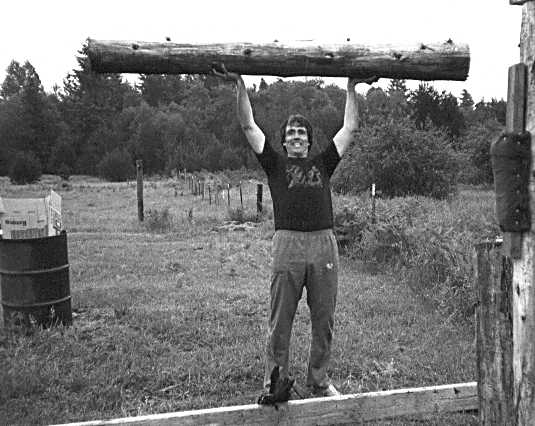
 At
this point, Master Archibeque and I terminated the
interview, and I agreed to "try it" as he had
suggested. As the photographs show, the lift
proved to be quite a struggle for myself, even though
I can routinely stand and press in excess of 150
pounds. I asked that he walk us through some of his
other stations and explain how they are used. His
explanation follows.
At
this point, Master Archibeque and I terminated the
interview, and I agreed to "try it" as he had
suggested. As the photographs show, the lift
proved to be quite a struggle for myself, even though
I can routinely stand and press in excess of 150
pounds. I asked that he walk us through some of his
other stations and explain how they are used. His
explanation follows.

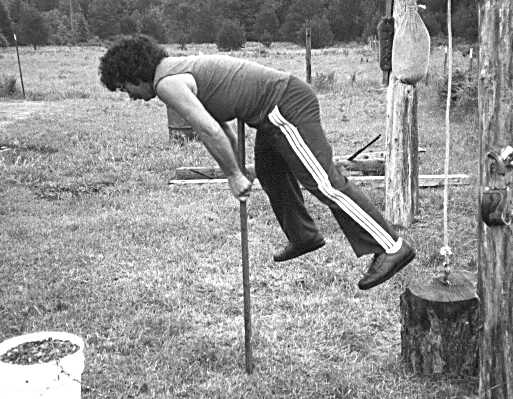
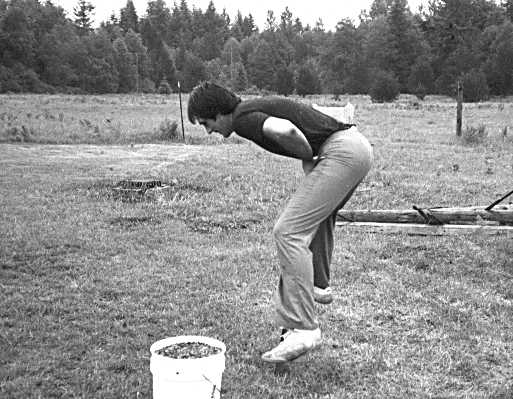
 "Even something so ordinary as
a horizontal bar presents genuine challenges. The next
time you see a horizontal bar, lie with your center of
gravity directly on the bar, then attempt to straighten
your body into one line. If you can do this, you can
join my class! If you can't, be satisfied with that
special feeling your body will have after having been
well-worked. Once you've mastered that exercise, stay on
the bar then try bending, touching your toes and
fingertips to the ground, then return to the horizontal
... the variations are endless."
"Even something so ordinary as
a horizontal bar presents genuine challenges. The next
time you see a horizontal bar, lie with your center of
gravity directly on the bar, then attempt to straighten
your body into one line. If you can do this, you can
join my class! If you can't, be satisfied with that
special feeling your body will have after having been
well-worked. Once you've mastered that exercise, stay on
the bar then try bending, touching your toes and
fingertips to the ground, then return to the horizontal
... the variations are endless." 